Instructional Design
Taxonomies
Two alternate taxonomies of the cognitive domain are presented in order to establish a context for examining approaches to instructional design. Each of these taxonomies proposes a conceptual framework for understanding what any model of instructional design should be intended to accomplish.
Bloom's Taxonomy of Learning Objectives
Bloom’s taxonomy of learning objectives (original and revised) is conventionally depicted as a pyramid comprising six horizontal layers, each layer representing a distinct learning objective. It is a model used as a framework for formulating pedagogical strategies. In the original version, the layer situated at the base of the pyramid is labeled “remembering,” and the layer located at the apex is labeled “evaluation.” In the revised version, the bottom layer is labeled "remember," and the layer at the apex is labeled "create,"
In many contemporary pedagogical circles that embrace Bloom's taxonomy, ascending to “creating” at the apex is exalted, while trifling with mere “remembering” at the base is denigrated. For example, rote memorization of basic facts is typically frowned upon, despite the fact that it can be very effective for rendering such things as state capitals or basic math facts immediately recalled without the need to look them up or calculate them on the spot.
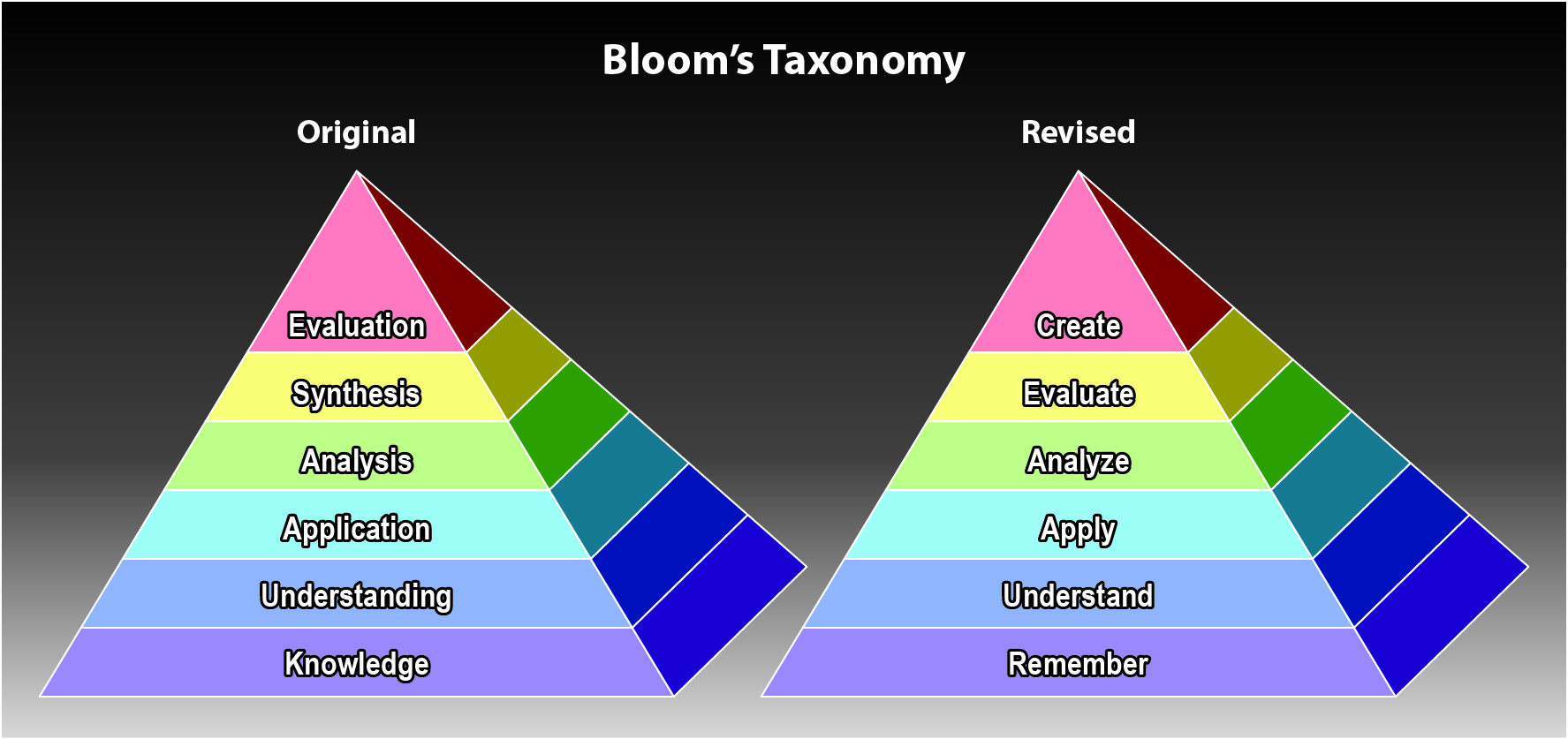 Anderson & Krathwohl's Taxonomy of the Cognitive Domain
Anderson & Krathwohl's Taxonomy of the Cognitive Domain
Rather than arranging learning objectives in a single, vertical dimension, Anderson and Krathwohl's taxonomy consists of a matrix that comprises two dimensions, the cognitive-process dimension and the knowledge dimension. Anderson and Krathwohl recognized that the several cognitive processes that are arranged hierarchically in Bloom's taxonomy apply to each of the following four types of knowledge:
- Factual knowledge,
- Conceptual knowledge,
- Procedural knowledge, and
- Meta-cognitive knowledge.
Bloom's placement of knowledge at the bottom of his original hierarchical taxonomy and the relegation of remembering to the base of the revised version suggest that he did not regard the "mere" acquisition of knowledge or remembering very highly. In reality, however, a principal product of Bloom's higher-order cognitive functions – application, analysis, synthesis, etc – is precisely the broadening and deepening of knowledge and the elaboration of increasingly complex cognitive schemata. Only then can the creation of new theories, hypotheses, and conjectures constitute meaningful progress. Anderson and Krathwohl's breaking off of knowledge as a separate dimension from cognitive processes reflects recognition of this important distinction. In my estimation, Anderson and Krathwohl's matrix reflects the reality of the cognitive domain with greater fidelity than Bloom’s taxonomy.
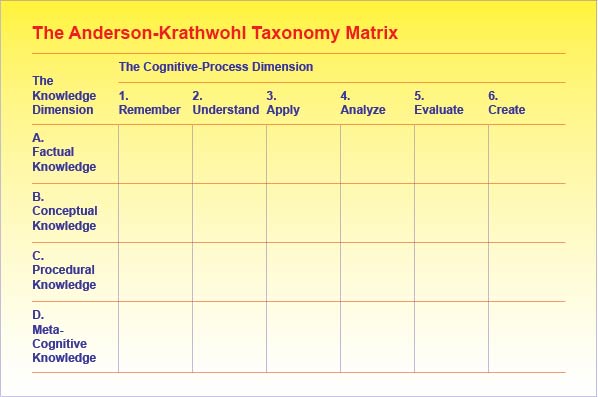
Approaches to Instructional Design
Robert Gagné's Nine Events of Instruction
Robert Gagné's nine events of instruction focus on the classroom delivery of instruction and on interaction with the learner rather than on the analysis of the learner or subject matter, or on the development of istructional materials per se. Gagné's nine events presuppose that the up-front analysis of subject matter and learner and definition of learning objectives have already been completed. The first three events address preparing the learner to receive the instructional stimulus: gaining the learner's attention, informing the learner of objectives, and stimulating recall of prior learning. It should be noted that, while the nine events preserve some behaviorist elements (e. g., "present stimulus," "elicit response," etc.), they also reflect cognitive influence (e. g., "inform learner of objectives," "provide learning guidance," etc.).

Dick and Carey Model
Dick and Carey's model for instuctional design begins by identifying goals and analyzing instructional requirements and entry behaviors in parallel. Performance objectives are then written based on those analyses. Interestingly, criterion-referenced tests are developed
before the instructional strategy is developed, reflecting Robert Mager's influence. Only then are instructional materials selected and developed in accordance with the instructional strategy, followed by the development and implementation of formative and summative evaluations. Dick and Carey's model also allows for the recursive review and potential revision of the entire process.
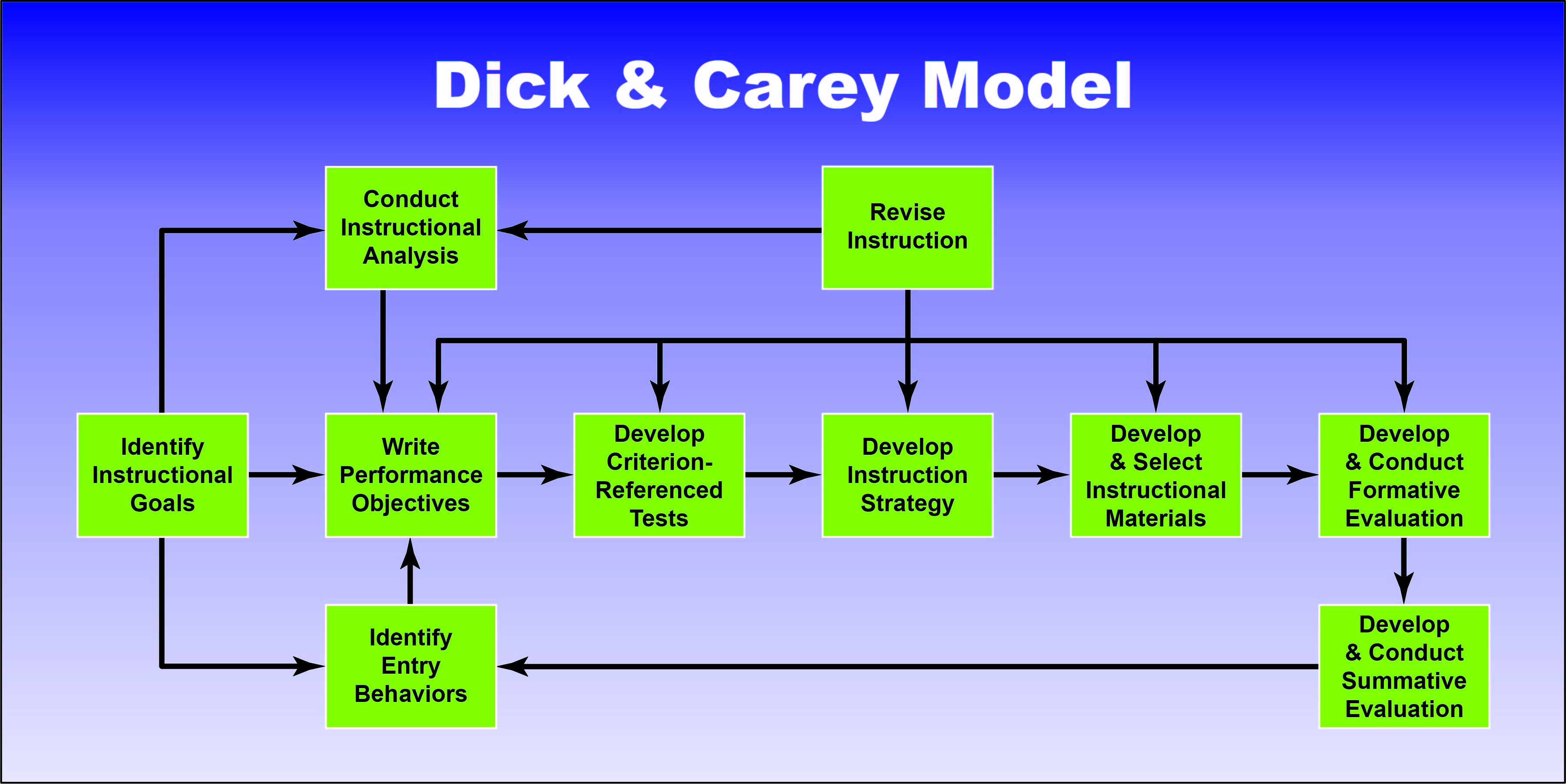
The ADDIE Model
Derived from Dr. Robert Branson's research to improve the efficiency and effectiveness of military training, the ADDIE (
Analyze,
Design,
Develop,
Implement, and
Evaluate) model has been a mainstay of the Learning and Development community for many years, especially in commercial and industrial training contexts. Though the ADDIE model is usually depicted as a linear process beginning with Analyze and culminating with Evaluate, I have depicted it here in a circular configuration to emphasize that the model is actually cyclically recursive. When an instructional designer finishes one cycle in the process, he or she may find that the product or process for which instruction has been developed has evolved, or oversights may have occurred during the development process that require rectification, and the entire cyclical process must be repeated. Indeed, with the ADDIE model, evaluation is an on-going process, and one can act upon evaluative observations at any point in the process. So, some flexibility is built into ADDIE.
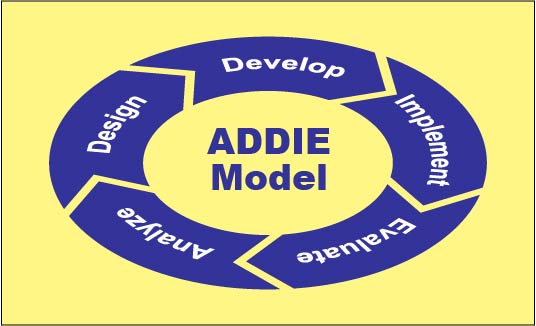
Successive Approximation Model (SAM)
Dr. Michael Allen's Successive Approximation Model is actually a variation of the ADDIE model in which the process is broken down into three phases, so as to coincide with the phases of the Agile product-development methodology:
- The Preparation Phase,
- The Iterative Design Phase, and
- The Iterative Development Phase.
In the preparation phase, background information is gathered and organized – audience analysis, product or process information, etc. – as necessary to map out a preliminary strategy for proceeding. The preparation phase culminates in a "savvy start," in which the design and development phases are mapped out and design work commences. Each of the remaining phases is structured like recursive "mini-ADDIEs." The iterative design phase comprises project planning and additional design; An instructional prototype is designed, evaluated, and revised as necessary until it is ready for development. In the iterative development phase, an instructional design proof is developed, implemented as in a "sandbox," evaluated, and refined recursively, proceeding through alpha, beta, and gold stages untill the instructional design is ready for rollout.
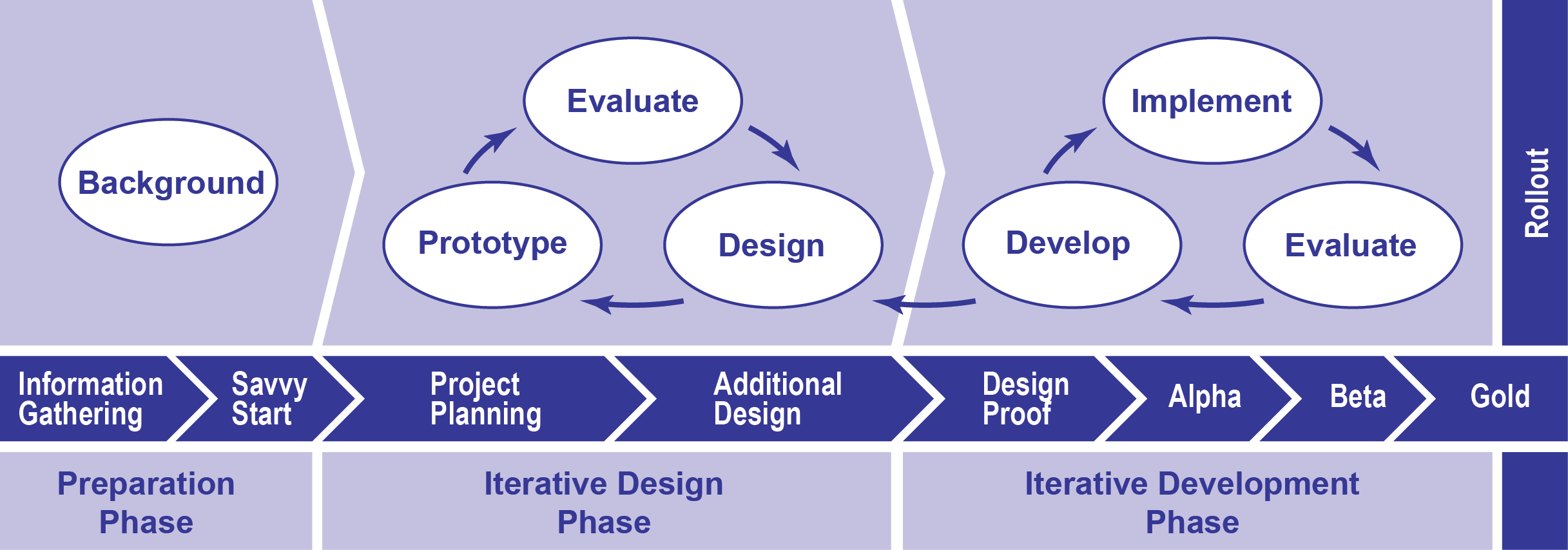
Training Evaluation
Kirkpatrick's Four Levels of Training Evaluation
Presumably, a training program was initiated in order to solve some quantifiable problem: the return on investment is failing to meet targeted levels, production or quality levels have fallen off, or customer complaints have increased significantly. The problem is attributed to poor worker performance, and the need for further training has been identified as the culprit. So, a new training program has been instituted, the instruction has been designed and implemented, training has been delivered, learners are back at work, and management needs to verify that the program is successful at solving the problems. In order to provide this verification, Kirkpatrick's four levels of training evaluation include the following:
- Level 1: Learners' Reaction – Measure whether the learners have found the training to be relevant to their respective roles, engaging, and useful.
- Level 2: Effective Learning – Measure how well the learners have acquired the knowledge, skills, attitudes, confidence, and commitment on which the training program is focused.
- Level 3: Impact on Behavior – Measure behavioral changes after learning takes place to see whether learners are actually applying what they learned in training as they do their jobs.
- Level 4: Achieving Results – Measure how well the training program (alongside the support and accountability of organizational members) achieved the targeted outcomes.
Teaching & Training Experience
I have taught at the college and university level, from GED preparation programs to technical courses such as computer-aided design and computer software applications, as well as more academic courses including psychology, graphic design, and humanities. I have taught face-to-face in classrooms as well as in blended formats using learning-management systems, in class sizes ranging from one-on-one tutorials to dozens of learners at a time.
I have also provided technical training in industrial contexts. In keeping with
Adult Learning Theory, I take a pragmatic, eclectic approach to instructional design, adapting my methods to situational exigencies. In conjunction with teaching, I have analyzed learner needs and subject-matter requirements and developed instructional strategies based on those analyses. My background in industrial products, systems, and processes, coupled with my background in teaching and learning, enables me to recognize needs for training readily and to develop and implement strategies for meeting those needs. I have also designed and produced instructional materials to support teaching and training, as reflected among my
Work Samples.


 Anderson & Krathwohl's Taxonomy of the Cognitive Domain
Rather than arranging learning objectives in a single, vertical dimension, Anderson and Krathwohl's taxonomy consists of a matrix that comprises two dimensions, the cognitive-process dimension and the knowledge dimension. Anderson and Krathwohl recognized that the several cognitive processes that are arranged hierarchically in Bloom's taxonomy apply to each of the following four types of knowledge:
Anderson & Krathwohl's Taxonomy of the Cognitive Domain
Rather than arranging learning objectives in a single, vertical dimension, Anderson and Krathwohl's taxonomy consists of a matrix that comprises two dimensions, the cognitive-process dimension and the knowledge dimension. Anderson and Krathwohl recognized that the several cognitive processes that are arranged hierarchically in Bloom's taxonomy apply to each of the following four types of knowledge:




